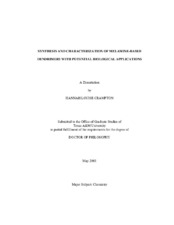| dc.description.abstract | The convergent strategy towards dendrimer synthesis is well-suited to generate macromolecules with a diverse periphery, at the expense of time and effort, while the divergent strategy has historically been effective at yielding higher generation dendrimers, although they are often plagued by impurities. Both the convergent and divergent routes were applied to the synthesis of melamine-based dendrimers, offering a comparison of the routes within a system. Generation-1 dendrons heterogeneously functionalized with Boc-protected amines and hydrazones were synthesized convergently and coupled to a generation-1 tris(piperazine) core to yield a generation-2 dendrimer bearing 18 Boc-amines and three hydrazones. Although the yield for the final coupling step was rather low (56%), the yields for all intermediate steps were quite high. Attempts toward obtaining a generation-3 dendrimer through this route were unsuccessful due presumably to steric hindrance. The materials obtained showed no impurities in their 1H and 13C NMR and mass spectra, although several chromatographic purifications were necessary throughout the synthesis. A divergent strategy based on addition of a dichlorotriazine monomer to polyamine cores was used to synthesize dendrimers of generations 1-5. All intermediates and dendrimers were either purified by precipitation, or did not need purification. 1H NMR spectroscopy indicated that reactions were complete up to G4-NH2 by integration, and mass spectroscopy confirmed that assignment. HPLC and GPC of Gn-Cl dendrimers showed sharp peaks for G1-G3, but G4-Cl appeared to have a small amount of impurities that are similar in size and polarity to the fully-substituted dendrimer. The G1-G3 dendrimers were confidently assigned as pure by conventional organic chemistry standards, but the assignment of purity to higher generations remained tentative. A G1-Cl dendrimer was functionalized with imidazole, and then deprotected and PEGylated with PEG5000 to yield a water soluble dendrimer. The imidazole-capped, Boc-protected dendrimer and the deprotected dendrimer were characterized by 1H and 13C NMR spectroscopy and mass spectrometry. The degree of PEGylation on the PEGylated material could not be definitively ascertained; however, the material is capable of solubilizing very hydrophobic Zn-phthalocyanines in water. | en |


